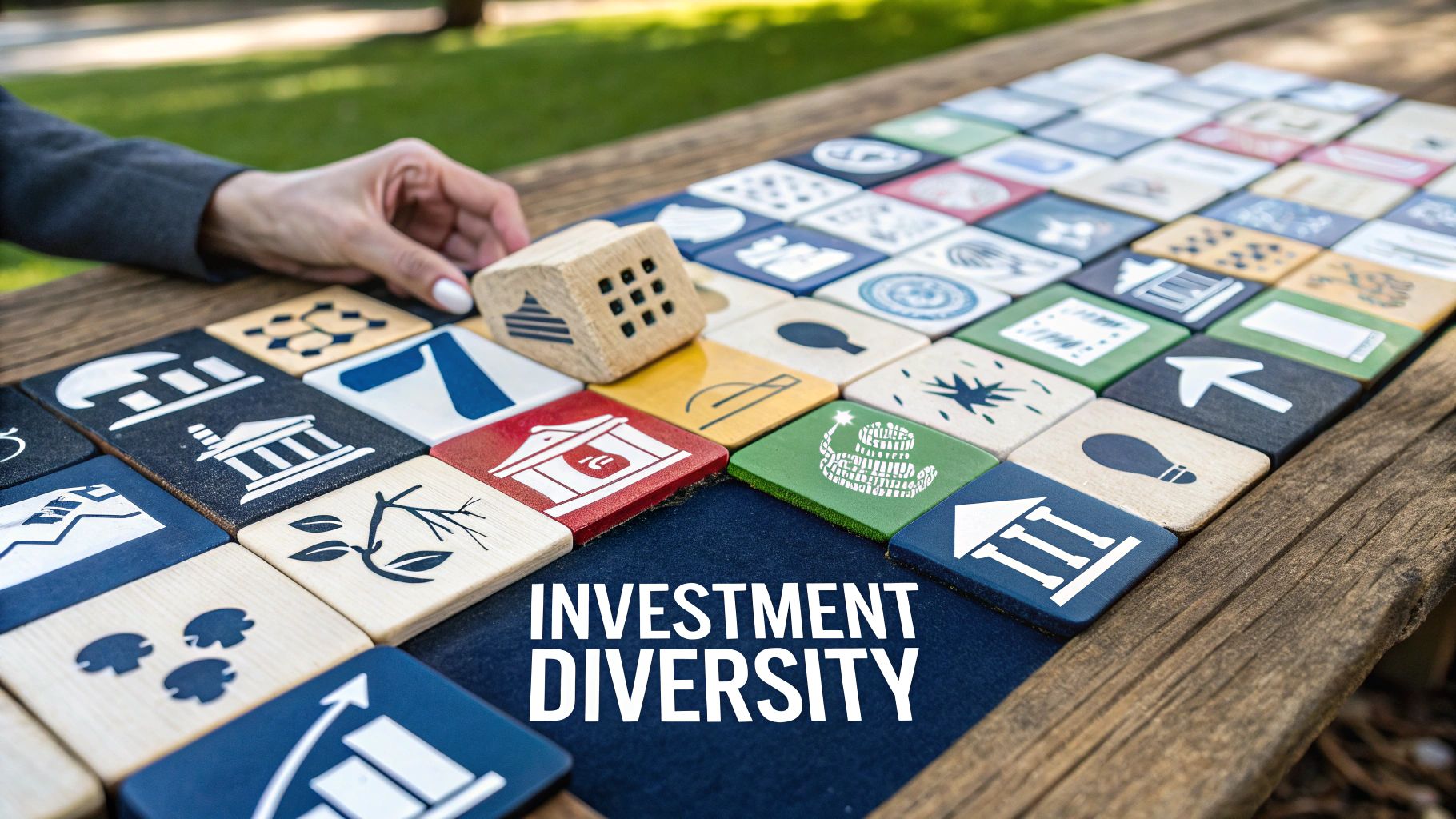Understanding the Power of Smart Diversification

The key to smart investing lies in spreading your money wisely across different types of investments. Rather than just randomly scattering funds, successful diversification requires understanding how various investments perform under different market conditions. This knowledge helps build a portfolio that can both protect against losses and capture growth opportunities.
Why Diversification Matters
The basic idea is simple - avoid putting everything into one investment. When some investments perform poorly, others may do well, helping protect your overall portfolio. Take the dot-com crash as an example: investors who held only tech stocks saw major losses, while those who also owned real estate and bonds fared much better. This illustrates why risk management through diversification is so important.
Diversification can also help boost your returns. Different types of investments react differently to economic changes. By owning a mix, you increase your chances of benefiting from various market conditions. As investment pioneer Harry Markowitz noted, diversification is investing's "only free lunch" - it can lower risk without giving up potential returns. Research shows that well-diversified portfolios tend to outperform concentrated ones over time. Learn more about diversification research
Common Misconceptions About Diversification
Many investors misunderstand what true diversification means. Some think it's just about owning lots of different stocks. But real diversification requires investing in assets that don't move in lockstep with each other. For example, owning shares of multiple tech companies isn't truly diversified since they often rise and fall together.
Another myth is that you need a big portfolio to diversify effectively. Even with modest amounts to invest, you can achieve good diversification through index funds and ETFs. These let you own pieces of many different investments with a relatively small amount of money.
A Practical Guide to Building a Diverse Portfolio
Start by examining your comfort with risk and your investing goals. Are you focused on protecting what you have, or are you willing to take more risk for potentially higher returns? Your answers will help determine how to divide your money between different types of investments.
Consider the main investment categories available:
- Stocks for growth potential
- Bonds for stability
- Real estate for income and appreciation
- Commodities for inflation protection
Finally, make sure to review and adjust your portfolio regularly. As markets move, your mix of investments can drift away from your targets. Rebalancing - selling some winners and buying more of the underperformers - helps keep your portfolio aligned with your goals and risk tolerance.
Building Your Multi-Asset Investment Strategy

Creating a strong investment portfolio requires more than just mixing stocks and bonds. The key is carefully selecting investments across multiple asset classes to build something that can both grow and protect your wealth over time. Let's explore how to construct a resilient portfolio that aligns with your goals.
Let's first examine how different asset classes compare in terms of risk and potential returns:
| Asset Class | Risk Level | Expected Return | Correlation Benefits |
|---|---|---|---|
| Stocks | High | 8-10% | Core growth driver |
| Bonds | Low-Medium | 3-5% | Counter to stocks |
| Real Estate | Medium-High | 6-8% | Income + appreciation |
| Commodities | High | 4-6% | Inflation hedge |
| Cash | Very Low | 1-2% | Safety, liquidity |
Beyond Traditional Investments
While stocks and bonds serve as portfolio foundations, other assets can add important benefits. Real estate provides steady rental income plus potential value growth. Commodities like gold or agricultural products help protect against inflation. Private equity and hedge funds offer ways to access different market opportunities. A balanced mix across these areas helps smooth out portfolio performance over time. For stats on how diversification has historically helped investors, check out Morningstar's research on portfolio diversification.
Making Assets Work Together
Understanding how investments move relative to each other - their correlation - is crucial. You want assets that don't all rise and fall together. For example, when stocks drop during economic uncertainty, bonds often gain value as investors seek safety. This balance helps keep your overall portfolio more stable.
Choosing What Fits Your Needs
The right mix depends on factors like your risk comfort level, investment timeline, and financial targets. Younger investors with decades ahead might focus more on growth through stocks. Those near retirement typically shift toward steady income from bonds and dividend stocks.
New Investment Frontiers
Fresh opportunities keep emerging in areas like digital assets, sustainable infrastructure, and tokenized real estate. While these can add valuable diversification, start small and research thoroughly before committing significant funds. Build knowledge and exposure gradually.
Aligning With Your Goals
Your asset mix should match your specific objectives. Are you saving for a house down payment? Planning for retirement? Funding education? Your timeline and targets guide how to spread investments across different asset types.
Staying Flexible as Markets Change
Markets never stand still, so review and rebalance regularly. This means selling some winners and buying more laggards to maintain your target allocation. This disciplined process keeps your portfolio aligned with your goals through changing conditions.
Mastering Global Market Opportunities

Adding global markets to your investment mix can help build a stronger portfolio, though it requires careful planning and research. Understanding how different markets relate to each other and their unique risks is essential for success.
The Reality of Market Connections
The idea that international markets move independently used to be a key reason for global investing. When one market fell, another might rise, helping balance portfolio returns. But research shows markets have become more connected since the 1970s. By the 2000s, global financial integration had dramatically increased these connections. Learn more about market correlations. This means investors need smarter approaches to find true diversification benefits.
Finding Growth in Emerging Markets
While major markets often move together, emerging markets still offer unique opportunities. These developing economies tend to follow their own paths more than established markets. A U.S. market drop may have little effect on certain Southeast Asian investments. However, emerging markets bring extra challenges like unstable governments and shifting currency values. Thorough analysis is vital before investing.
Working with Currency Risk
Global investing means dealing with foreign currencies. Currency changes can significantly impact your returns both ways - a stronger U.S. dollar reduces foreign investment gains, while a weaker dollar boosts them. Currency hedging tools can help protect against these swings, though they add costs and complexity to your strategy.
Key Factors for International Investment
Success in global markets requires understanding specific regional factors:
- Growth outlook: What's driving the economy?
- Government stability: Are there political risks?
- Investment rules: How open is the market to foreign investors?
- Currency stability: How reliable is the local money?
Creating Your Global Plan
Build an international strategy by:
- Setting clear investment goals
- Understanding your comfort with risk
- Deciding how much to put in foreign markets
- Choosing investment methods (funds, stocks, etc.)
- Checking and adjusting regularly
Ways to Invest Globally
You can access international markets through:
- Global mutual funds and ETFs: Pre-built portfolios of foreign investments
- ADRs: Foreign company shares traded on U.S. exchanges
- Direct foreign investment: Buying stocks through international brokers
By carefully weighing these elements and building a clear plan, you can add global investments to help meet your financial goals.
Measuring Your Diversification Success

Tracking overall portfolio returns only tells part of the story. To truly understand if your diversification strategy works, you need to dig deeper into specific metrics and performance indicators. Let's explore how to effectively measure diversification success.
Evaluating Performance Beyond Returns
A concentrated portfolio focused on a single sector might deliver outstanding returns during certain market cycles. For example, tech-heavy portfolios soared in the late 1990s but crashed hard when the dot-com bubble burst. That's why looking at returns alone can be misleading.
A fascinating study by TCI Wealth compared two portfolios over 25 years. The first spread investments across multiple countries, company sizes, and value factors. The second focused solely on S&P 500 stocks. The results showed strong evidence for diversification benefits over the long term.
Historical Performance Comparison
| Time Period | Diversified Portfolio | Single Market Portfolio | Difference |
|---|---|---|---|
| 1995-2000 | +14.2% | +28.5% | -14.3% |
| 2000-2005 | +8.4% | -2.3% | +10.7% |
| 2005-2020 | +7.9% | +7.1% | +0.8% |
Key Metrics for Measuring Success
These important indicators help assess portfolio diversification:
- Standard Deviation: Measures return volatility - lower numbers suggest more stable performance
- Beta: Shows how your investments move compared to the market - below 1.0 means less volatility
- Sharpe Ratio: Evaluates returns per unit of risk - higher is better
- Maximum Drawdown: Your biggest loss from peak to bottom - smaller drops indicate better protection
Active Portfolio Management
Good diversification requires ongoing attention. Key steps include:
- Regular Rebalancing: Sell some winners and buy underperformers to maintain target allocations
- Market Analysis: Stay informed about economic trends that could impact different assets
- Performance Review: Compare results against goals and benchmarks to spot needed adjustments
Real World Examples
Looking at actual cases helps illustrate diversification in action. During the 2008 financial crisis, many diversified portfolios held up better than those concentrated in financial stocks. However, focused portfolios sometimes outperform during strong bull markets in specific sectors.
This mix of outcomes shows why diversification isn't about maximizing returns in any single period. Instead, it aims to deliver more reliable long-term results with fewer dramatic swings along the way.
By consistently tracking these metrics and making thoughtful adjustments, you can build and maintain an effective diversification strategy aligned with your investment goals.
Implementing Your Personal Diversification Plan
Let's explore how to put diversification into practice. This section walks through the key steps to build a well-balanced investment portfolio that matches your needs.
Defining Your Investment Goals and Risk Tolerance
Start by getting clear on what you want to achieve. Are you planning for retirement, saving for a house, or building a college fund? Your specific goals and timeline shape how you should invest. Next, be honest about your comfort level with risk. Consider how you'd feel if your investments dropped 20% - this helps determine the right mix of growth-focused and stable investments for you.
Selecting Specific Investments
With your goals and risk tolerance in mind, you can choose investments that fit. If you're focused on long-term growth, you might put more money in stocks across different industries like tech, healthcare, and consumer goods. For stability, bonds and CDs can help protect your savings. Take time to research each investment's risks - even similar-looking options can perform quite differently.
Determining Optimal Allocation Percentages
Getting the right investment mix is key. The classic 60/40 split puts 60% in stocks and 40% in bonds, but your ideal mix depends on your situation. Someone in their 20s might choose 80-90% stocks for growth potential, while someone near retirement may want more bonds for safety. Consider talking to a financial advisor to get a personalized plan.
Implementing Your Strategy Efficiently
When putting your plan into action, think about the best way to invest. Index funds and ETFs make it simple to spread your money across many investments at once. For example, one S&P 500 fund gives you a stake in 500 major U.S. companies. You can also buy individual stocks and bonds for more control, though this takes more research and hands-on management. Compare costs and how much time you want to spend managing investments.
Utilizing Tools and Platforms
Many online services help make diversification easier. Robo-advisors handle the details of building and rebalancing your portfolio based on your preferences. Investment platforms provide research tools and educational content to help you make good choices. These can be especially helpful when you're starting out or prefer a more automated approach.
Making Confident Investment Decisions
Create a portfolio that matches your needs and goals. Think about your timeline - are you investing for next year or the next 30 years? This affects how much risk you can take on. Also consider whether you want to actively manage your investments or take a more hands-off approach with index funds. Taking time to think through these choices helps build a portfolio that works for you.
Remember that diversification is ongoing work, not a one-time task. Check your portfolio regularly and adjust when needed to keep your target investment mix on track. This helps ensure your investments continue supporting your financial goals as markets change over time.
Maintaining Long-Term Investment Success
Smart portfolio management requires ongoing attention and regular adjustments to maintain alignment with your goals. Here are proven methods from experienced investors for keeping your investments healthy over time.
Portfolio Rebalancing: A Systematic Approach
Market movements can push your asset mix away from its original targets, potentially increasing risk. Portfolio rebalancing helps restore balance by selling some winners and buying more of the underperformers. Think of it like gardening - you trim back overgrown areas while nurturing smaller sections to maintain optimal proportions. For instance, if stocks grow from your target 60% to 70% of holdings, you'd sell some stocks and buy bonds to return to your planned 60/40 mix.
Evaluating New Investment Opportunities
The investment world constantly presents new options to consider. When analyzing these, focus on key factors like risk level, return potential, and how they fit with your current investments. Take emerging markets as an example - while they might offer strong growth possibilities, they come with higher volatility. Deep research and careful analysis should guide any portfolio additions.
Adapting to Changing Market Conditions
Markets never stand still. Economic shifts, global events, and interest rate changes can all affect your investments significantly. Successful investors stay flexible in their approach. This might mean adjusting your asset mix, exploring different investment types, or modifying your overall strategy. While diversification can't prevent all losses, it helps weather market turbulence more effectively. During high inflation periods, for instance, many investors increase their holdings in commodities as a protective measure.
Monitoring and Review: The Keys to Ongoing Success
Set up regular portfolio checkups to track important metrics like performance, asset mix, and risk levels. This information shows how well your investments are doing and where improvements might help. Look beyond just the numbers too - consider whether your investments match your values through options like sustainable investing. Consistent monitoring plus disciplined reviews helps you make smart, data-backed adjustments to optimize your portfolio over time.
Ready to learn more about building wealth and successful investing? Check out The Covered Call Podcast https://thecoveredcallpod.com for real stories, expert insights, and practical strategies to help reach your financial goals and gain more independence.

